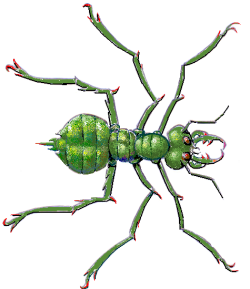Ranger ant
From Wikimalia
(Difference between revisions)
| Line 7: | Line 7: | ||
|notes= The ranger ant is so named because they are rarely encountered, generally in remote locations, and almost invariably as single specimens, giving rise to speculation that like rangers, they become easily lost. More likely they are a solo predator, or a colonial hymenoptera with vast hunting territories. Large enough to fend well against even small rodents and lizards, their half-thum mandibles are capable of delivering vicious bites, which will not release even if the insect is decapitated. | |notes= The ranger ant is so named because they are rarely encountered, generally in remote locations, and almost invariably as single specimens, giving rise to speculation that like rangers, they become easily lost. More likely they are a solo predator, or a colonial hymenoptera with vast hunting territories. Large enough to fend well against even small rodents and lizards, their half-thum mandibles are capable of delivering vicious bites, which will not release even if the insect is decapitated. | ||
}} | }} | ||
| + | |||
| + | {{stub}} | ||
| + | Back to the [[Insect/Arachnid]] page. | ||
Revision as of 14:44, 11 April 2008
| The Bug Collection | ||||||||
|---|---|---|---|---|---|---|---|---|
|
| ||||||||
| ||||||||
This article is a stub. You can help Wikimalia by expanding it.
Back to the Insect/Arachnid page.

